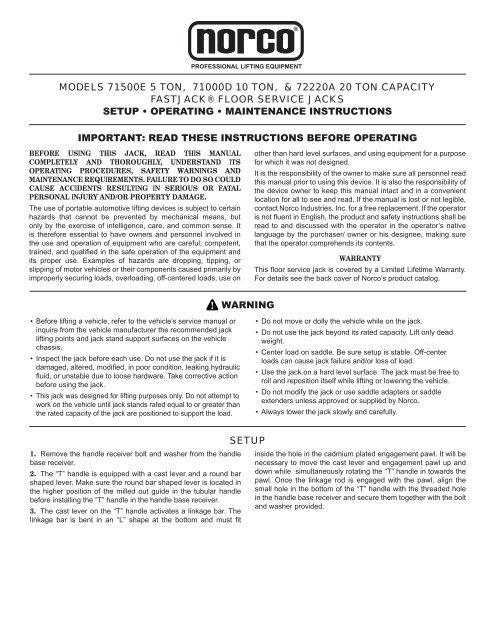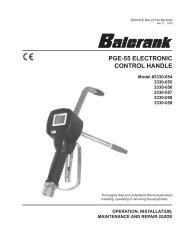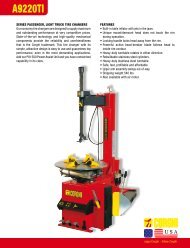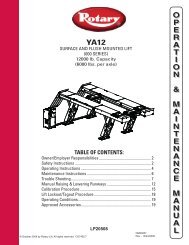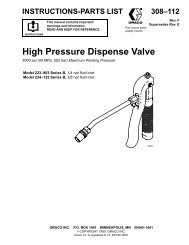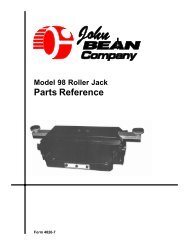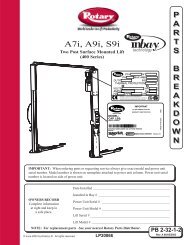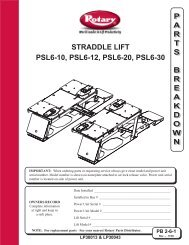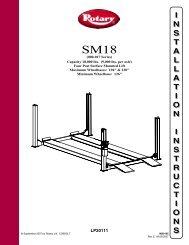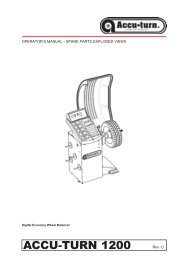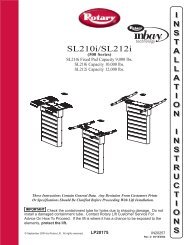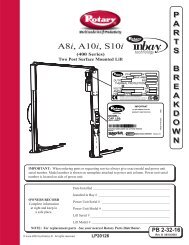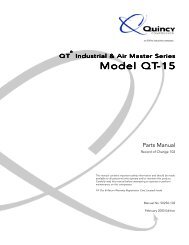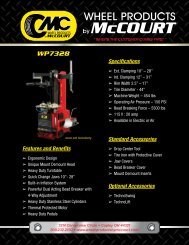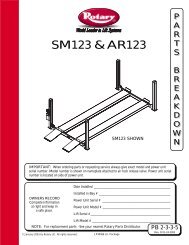models 71500e 5 ton, 71000d 10 ton, & 72220a 20 ton capacity ...
models 71500e 5 ton, 71000d 10 ton, & 72220a 20 ton capacity ...
models 71500e 5 ton, 71000d 10 ton, & 72220a 20 ton capacity ...
You also want an ePaper? Increase the reach of your titles
YUMPU automatically turns print PDFs into web optimized ePapers that Google loves.
PROFESSIONAL LIFTING EQUIPMENT<br />
MODELS 71500E 5 TON, 7<strong>10</strong>00D <strong>10</strong> TON, & 722<strong>20</strong>A <strong>20</strong> TON CAPACITY<br />
FASTJACK® FLOOR SERVICE JACKS<br />
SETUP • OPERATING • MAINTENANCE INSTRUCTIONS<br />
IMPORTANT: READ THESE INSTRUCTIONS BEFORE OPERATING<br />
BEFORE USING THIS JACK, READ THIS MANUAL<br />
COMPLETELY AND THOROUGHLY, UNDERSTAND ITS<br />
OPERATING PROCEDURES, SAFETY WARNINGS AND<br />
MAINTENANCE REQUIREMENTS. FAILURE TO DO SO COULD<br />
CAUSE ACCIDENTS RESULTING IN SERIOUS OR FATAL<br />
PERSONAL INJURY AND/OR PROPERTY DAMAGE.<br />
The use of portable automotive lifting devices is subject to certain<br />
hazards that cannot be prevented by mechanical means, but<br />
only by the exercise of intelligence, care, and common sense. It<br />
is therefore essential to have owners and personnel involved in<br />
the use and operation of equipment who are careful, competent,<br />
trained, and qualified in the safe operation of the equipment and<br />
its proper use. Examples of hazards are dropping, tipping, or<br />
slipping of motor vehicles or their components caused primarily by<br />
improperly securing loads, overloading, off-centered loads, use on<br />
• Before lifting a vehicle, refer to the vehicle’s service manual or<br />
inquire from the vehicle manufacturer the recommended jack<br />
lifting points and jack stand support surfaces on the vehicle<br />
chassis.<br />
• Inspect the jack before each use. Do not use the jack if it is<br />
damaged, altered, modified, in poor condition, leaking hydraulic<br />
fluid, or unstable due to loose hardware. Take corrective action<br />
before using the jack.<br />
• This jack was designed for lifting purposes only. Do not attempt to<br />
work on the vehicle until jack stands rated equal to or greater than<br />
the rated <strong>capacity</strong> of the jack are positioned to support the load.<br />
1. Remove the handle receiver bolt and washer from the handle<br />
base receiver.<br />
2. The “T” handle is equipped with a cast lever and a round bar<br />
shaped lever. Make sure the round bar shaped lever is located in<br />
the higher position of the milled out guide in the tubular handle<br />
before installing the “T” handle in the handle base receiver.<br />
3. The cast lever on the “T” handle activates a linkage bar. The<br />
linkage bar is bent in an “L” shape at the bottom and must fit<br />
WARNING<br />
SETUP<br />
®<br />
other than hard level surfaces, and using equipment for a purpose<br />
for which it was not designed.<br />
It is the responsibility of the owner to make sure all personnel read<br />
this manual prior to using this device. It is also the responsibility of<br />
the device owner to keep this manual intact and in a convenient<br />
location for all to see and read. If the manual is lost or not legible,<br />
contact Norco Industries, Inc. for a free replacement. If the operator<br />
is not fluent in English, the product and safety instructions shall be<br />
read to and discussed with the operator in the operator’s native<br />
language by the purchaser/ owner or his designee, making sure<br />
that the operator comprehends its contents.<br />
WARRANTY<br />
This floor service jack is covered by a Limited Lifetime Warranty.<br />
For details see the back cover of Norco’s product catalog.<br />
• Do not move or dolly the vehicle while on the jack.<br />
• Do not use the jack beyond its rated <strong>capacity</strong>. Lift only dead<br />
weight.<br />
• Center load on saddle. Be sure setup is stable. Off-center<br />
loads can cause jack failure and/or loss of load.<br />
• Use the jack on a hard level surface. The jack must be free to<br />
roll and reposition itself while lifting or lowering the vehicle.<br />
• Do not modify the jack or use saddle adapters or saddle<br />
extenders unless approved or supplied by Norco.<br />
• Always lower the jack slowly and carefully.<br />
inside the hole in the cadmium plated engagement pawl. It will be<br />
necessary to move the cast lever and engagement pawl up and<br />
down while simultaneously rotating the “T” handle in towards the<br />
pawl. Once the linkage rod is engaged with the pawl, align the<br />
small hole in the bottom of the “T” handle with the threaded hole<br />
in the handle base receiver and secure them together with the bolt<br />
and washer provided.
1. Become familiar with the levers on the “T” handle. The round<br />
bar shaped lever is spring loaded and follows a milled out guide<br />
in the tubular handle. The lever should be in the higher position of<br />
the milled out guide in order to activate the “quick rise” cast lever<br />
and pump the “T” handle.<br />
2. The “quick rise” lever may be pulled in order to activate the<br />
“quick rise” feature of the FASTJACK. Pulling the cast lever rotates<br />
the cadmium plated engagement pawl so it can come in contact<br />
with the first available lifting tooth. Once the pawl is in position,<br />
pulling down on the “T” handle engages the pawl with the lifting<br />
tooth. Once the tooth is engaged continue to push down on the<br />
handle and you will see the lift saddle raise. Raise the lift saddle<br />
slowly while simultaneously aligning the saddle with the frame<br />
or component to be lifted. Make sure the frame or component is<br />
centered on the lift saddle and not the peripheral edge of the saddle.<br />
If the frame or component is not centered on the saddle, lower the<br />
saddle, reposition the jack and try again. Once the saddle is in<br />
contact with the load, release the cast lever and proceed pumping<br />
the “T” handle until the load is lifted to the desired work height.<br />
3. Lowering the load can only be accomplished by positioning the<br />
“T” handle over one of the three holes in the handle base bracket,<br />
disengaging the round bar shaped lever from its high position and<br />
allowing it to drop to the low position, and rotating the lever to the<br />
right. The load cannot be released unless the lever is rotated to<br />
the right.<br />
4. With the jack in the lowered position, push the jack under the<br />
vehicle. IMPORTANT: Use the manufacturer’s recommended<br />
1. Always store the jack in a well protected area where it will not<br />
be exposed to inclement weather, corrosive vapors, abrasive dust,<br />
or any other harmful elements. The jack must be cleaned of water,<br />
snow, sand, or grit before using.<br />
2. The jack must be lubricated periodically in order to prevent<br />
premature wearing of parts. A general purpose grease must be<br />
applied to caster wheels, front axle wheels, elevator arm, handle<br />
base pivot bolts, release mechanism and all other bearing<br />
surfaces. See the exploded view parts drawing for the location of<br />
the above mentioned parts. Failure to maintain proper lubrication<br />
voids warranty.<br />
3. It should not be necessary to refill or top off the reservoir with<br />
hydraulic fluid unless there is an external leak. An external leak<br />
requires immediate repair which must be performed in a dirtfree<br />
environment by qualified hydraulic repair personnel who are<br />
familiar with this equipment. Norco Authorized Service Centers are<br />
recommended.<br />
If your Norco product requires service or repair, contact the Norco<br />
Customer Service Department for the location of the nearest Norco<br />
Authorized Service Center.<br />
Norco Industries, Inc.<br />
365 West Victoria St.<br />
Comp<strong>ton</strong>, CA 902<strong>20</strong><br />
(3<strong>10</strong>) 639-4000 • Fax: (3<strong>10</strong>) 639-7411<br />
www.norcoindustries.com<br />
OPERATING INSTRUCTIONS<br />
PREVENTATIVE MAINTENANCE<br />
REPAIR SERVICE<br />
lifting procedures and lifting points before lifting loads.<br />
5. Pump the “T” handle or use the “quick rise” feature to get the lift<br />
saddle close to the load. Now raise the lift saddle slowly, making<br />
sure the saddle comes in contact with the load, the load is centered<br />
on the saddle and the majority of the load is not supported by the<br />
peripheral edge of the lifting saddle at any single point.<br />
6. IMPORTANT: Check to see that the ground surface around<br />
the jack is free from wheel obstructions such as gravel, tools,<br />
or uneven joints or edges. The jack will have a tendency to<br />
reposition itself during the lifting process and therefore<br />
should not be hindered by wheel obstructions.<br />
7. Proceed with pumping the “T” handle so the load is lifted to<br />
the required work height. The “quick rise” feature is designed to<br />
eliminate all the incremental pumps required to bring the lifting<br />
saddle in contact with the load. The “quick rise” feature was<br />
not designed to lift the load. Lifting the load is accomplished by<br />
pumping the “T” handle.<br />
8. After lifting the load, always use approved vehicle support<br />
stands with an adequate <strong>capacity</strong> rating to support the load before<br />
making any repairs or adjustments. Position and adjust the stands<br />
under the load at points that will provide stable support. Lower<br />
the load SLOWLY AND CAREFULLY onto the support stands.<br />
Although support stands are individually rated, they are to be used<br />
in a matched pair to support one end of a vehicle only. Stands are<br />
not to be used to simultaneously support both ends or one side of<br />
a vehicle.<br />
IMPORTANT: In order to prevent seal damage and jack<br />
failure, never use alcohol, hydraulic brake fluid, or<br />
transmission oil in the jack.<br />
4. Every jack owner is responsible for keeping the jack label clean<br />
and readable. Use a mild soap solution to wash external surfaces<br />
of the jack but not any moving hydraulic components. Contact<br />
Norco Industries for a replacement label if your jack’s label is not<br />
readable.<br />
5. Inspect the jack before each use. Do not use the jack if any<br />
component is cracked, broken, bent, shows sign of damage, or<br />
leaks hydraulic fluid. Do not use the jack if it has loose or missing<br />
hardware or components, or is modified in any way. Take corrective<br />
action before using the jack again.<br />
6. Do not attempt to make any hydraulic repairs unless you<br />
are a qualified hydraulic repair person that is familiar with this<br />
equipment.<br />
It will be necessary to provide the Norco Authorized Service Center<br />
with a copy of the bill of sale if requesting warranty repair. If the<br />
authorized service center determines your product is eligible for<br />
warranty repair, the repair will be made at no charge and returned<br />
freight prepaid. The cost of non-warrantable service, repair, and<br />
return freight is the customer’s responsibility.<br />
71500E / 7<strong>10</strong>00D / 722<strong>20</strong>A


